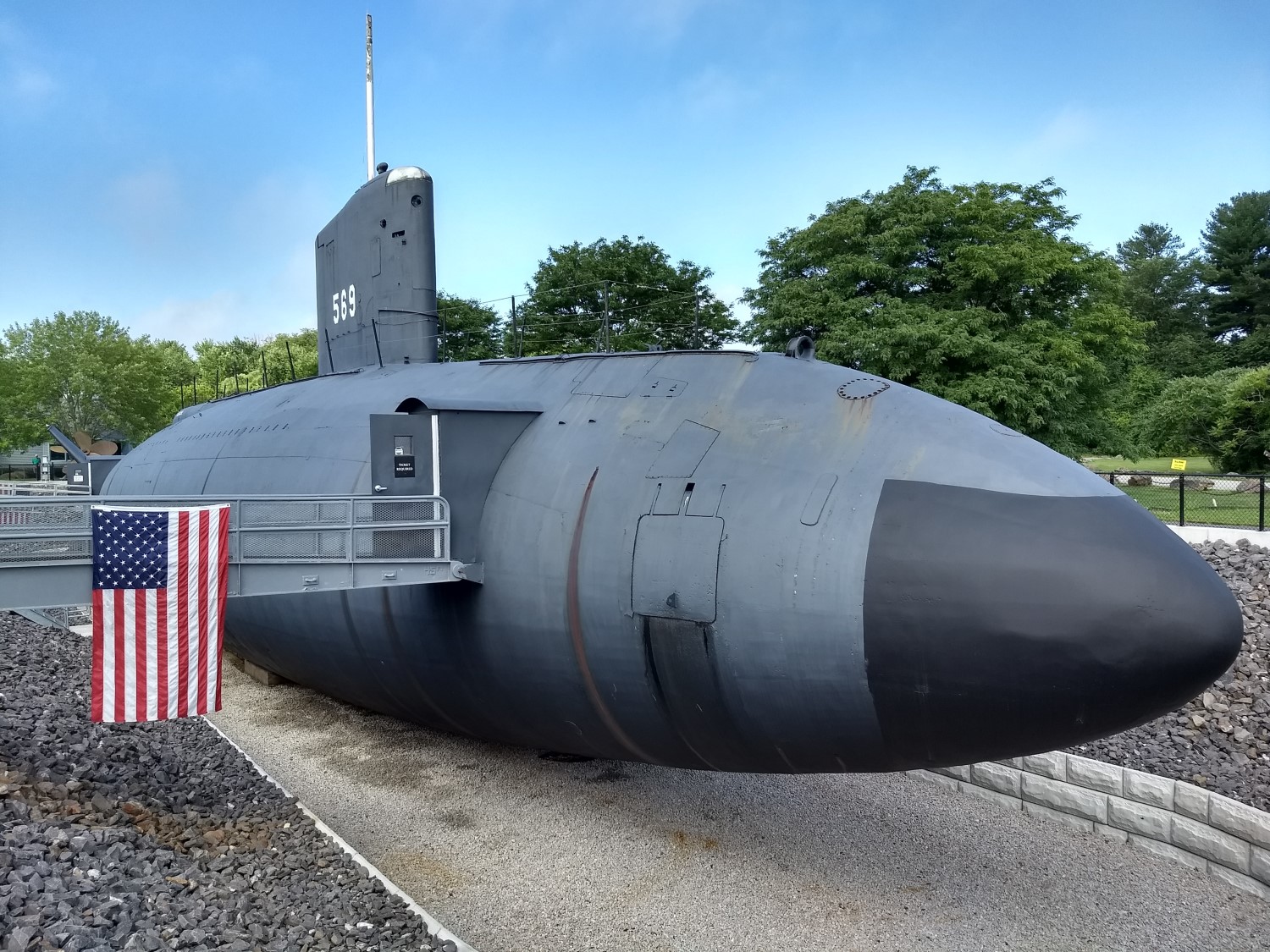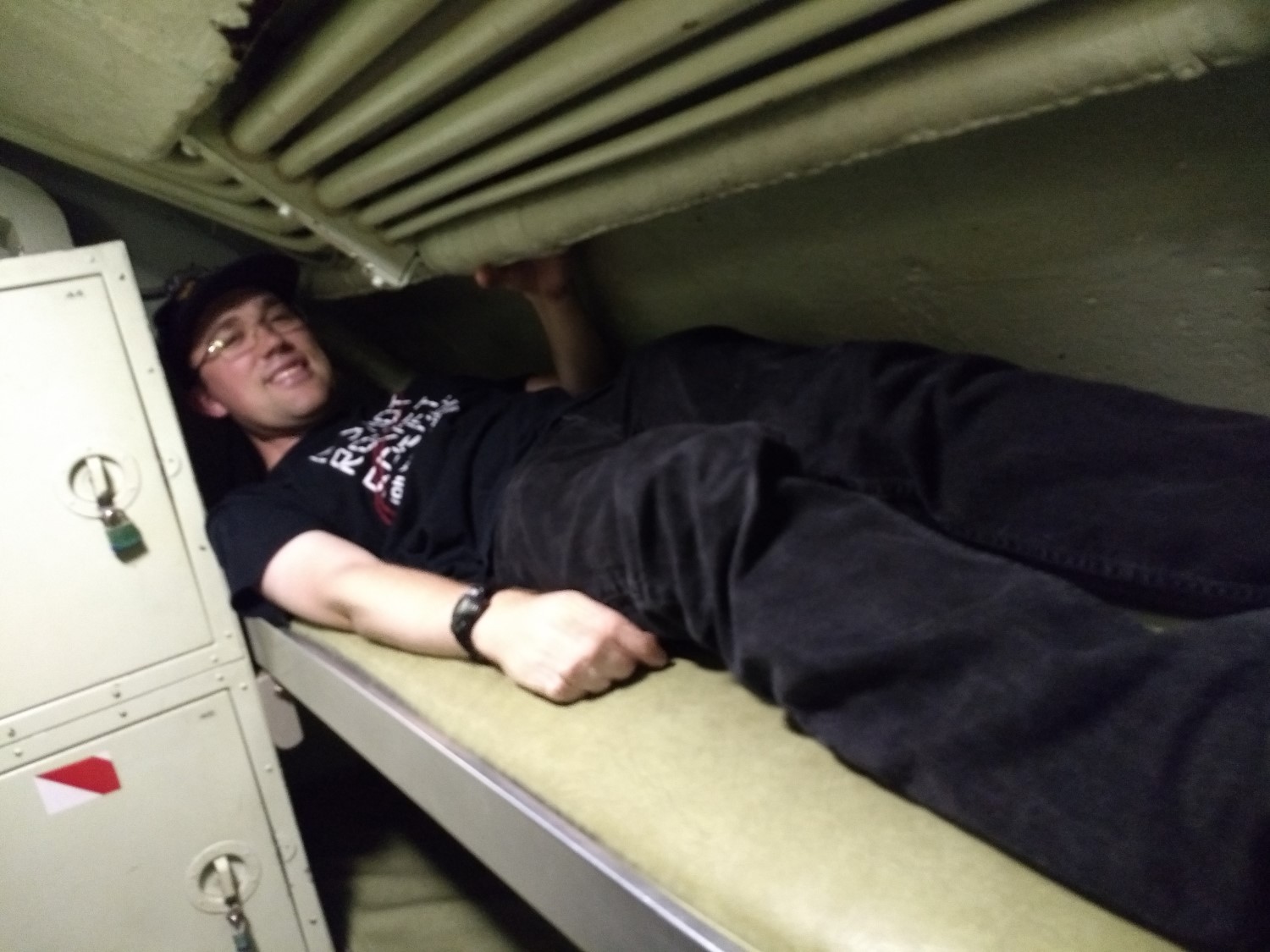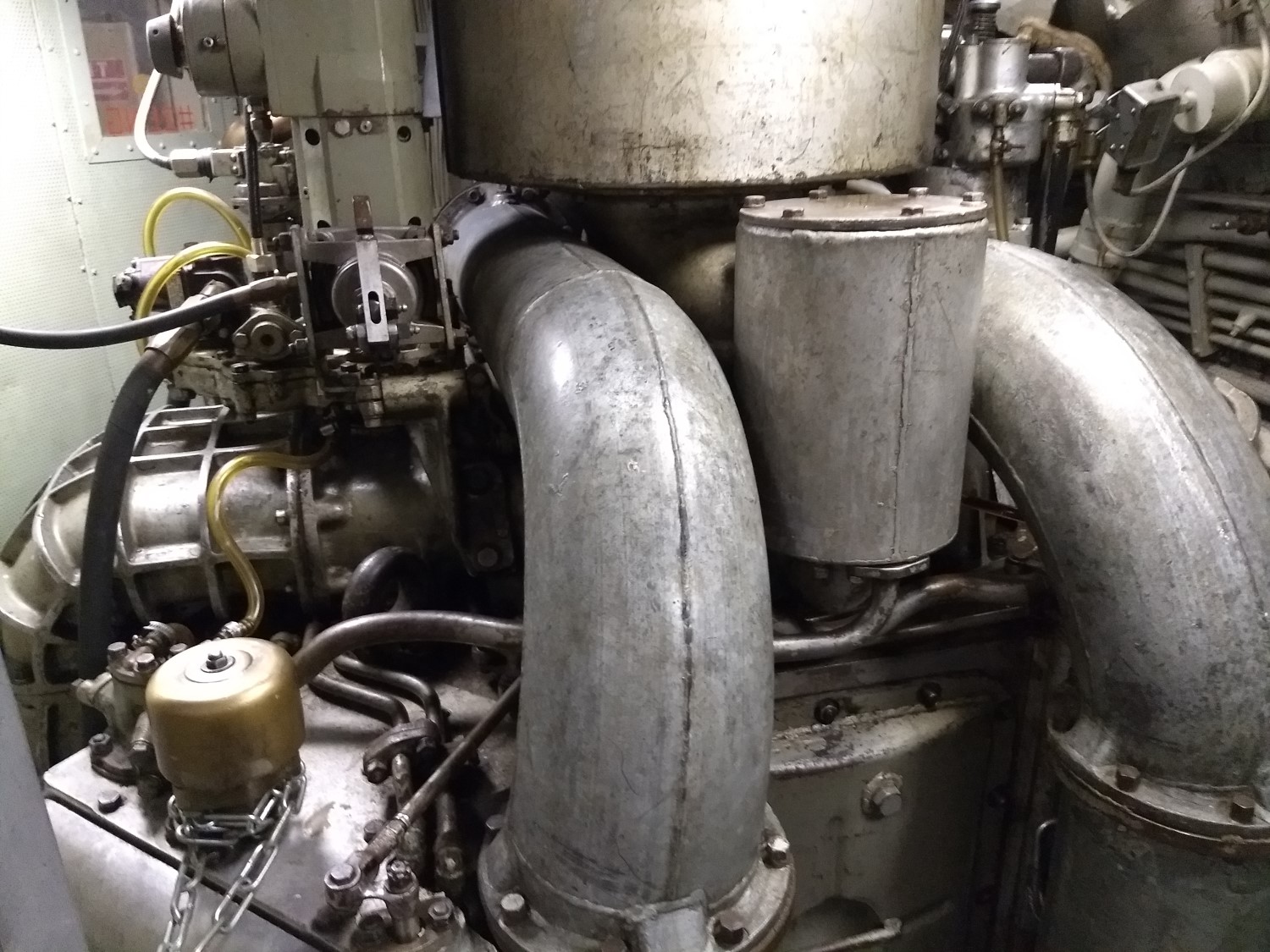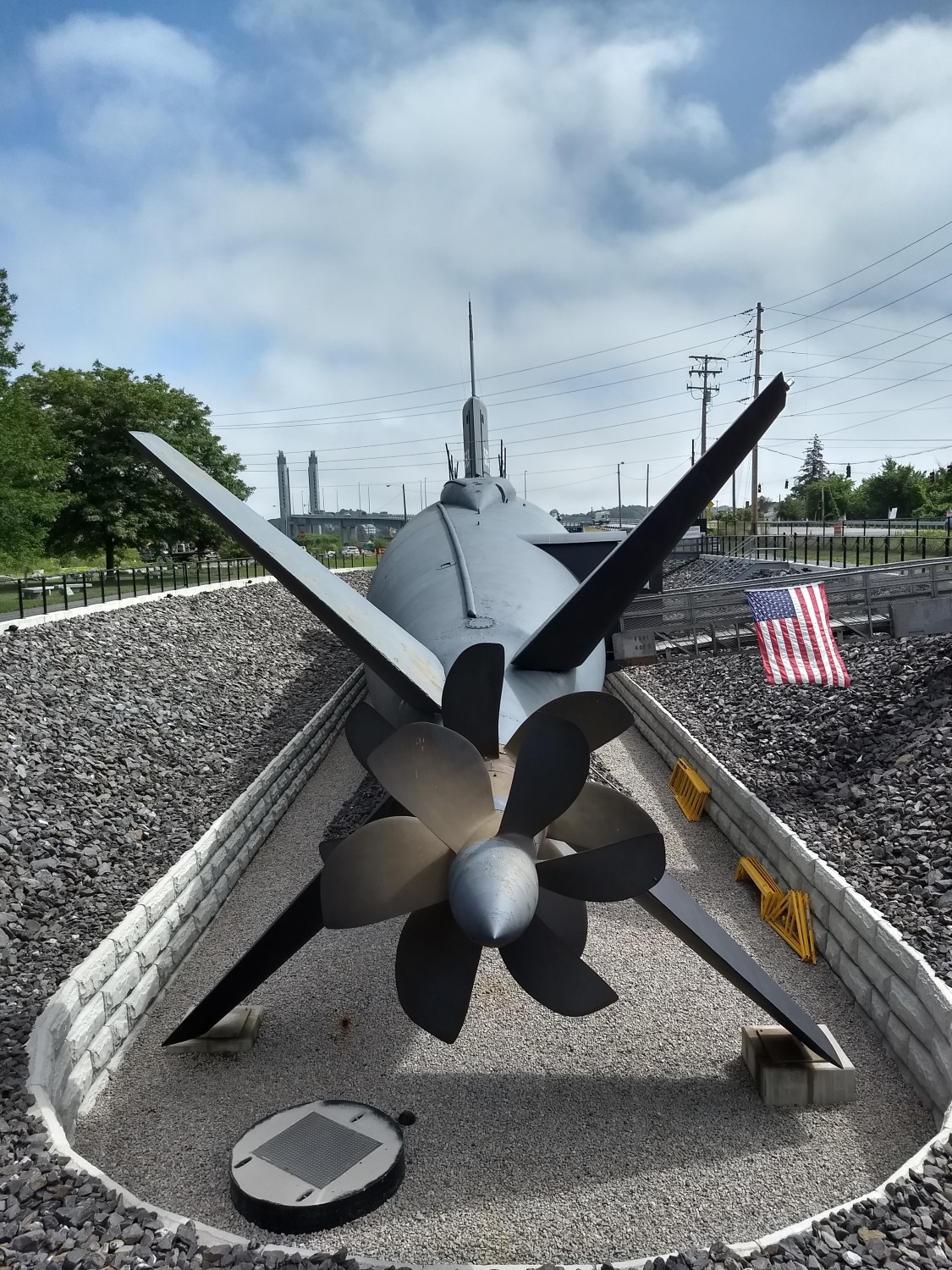On the morning of my last day in New England, I headed north to New Hampshire to see USS Albacore, the second of the vital forerunners of the modern submarine. Sister Bean had to go back to work, so I was on my own. While Nautilus had pioneered nuclear propulsion, she had retained the general hull design of previous submarines, only partially optimized for underwater operations. Albacore, while propelled by diesels and batteries, was the first to be fully designed for performance underwater.1

Me at the control panel, for real this time

Albacore was distinguished from every other submarine I've been to this summer by the near-complete absence of plexiglass and other barriers. All three other submarines, for instance, only let you walk through the corridor running through officer's country, with the spaces on either side blocked off. Albacore lets you go into the wardroom and staterooms and touch everything. The same was true pretty much all the way through the boat, which was really fun after having to deal with lots of stuff I could look at but not touch for the previous few days.

Me in one of the bunks. It was very tight.
Beyond that, the museum was done pretty well. The signage was a bit on the minimal side, but adequate. The audio tour was good, and I actually used it, unlike at most museums. And there was a lot of emphasis on Albacore's role as an experimental platform, instead of just talking about submarine life in general. I really liked that, as the alternative is to cover an area I've already seen discussed several times.

One of Albacore's pancake diesels
Unlike a lot of museum ships, nothing else was present, but I still enjoyed it greatly. The staff was friendly, and I spent a few minutes swapping tales with the guy in the gift shop. He said they'd thought they were the first submarine museum on dry land until someone told them about Batfish. I agreed, but said that they had done a much better job with their boat. I said I'd be glad to get back to Iowa, which was the best ship. He said I should enjoy my target, and I pointed out that I hadn't seen any torpedo tubes. He suggested they'd surface and throw rocks.

Albacore from dead astern. Note the X-shaped control surfaces and twin counterrotating propellers.
Overall, Albacore was a great way to finish my tour of the museum ships of New England. She wasn't the absolute standout, but I'm glad I paid her a visit.
1 OK, this isn't quite true. A number of the early submarines were optimized exclusively for underwater performance, but this was not particularly successful given the technology of the day, and it faded in favor of the submersible surface ship hull design by WWI. ⇑

Comments
Something that has never occurred to me until now: Nautilus and Albacore were both proof-of-concept technology demonstrators, as you note of roughly equal importance at the time. Why was Nautilus armed and fitted to serve as an operational boat, but not Albacore?
I can think of a couple factors that probably decided the issue. First, cost. Nuclear reactors are expensive. Diesel-electric submarines are not, relatively speaking. Second, size. Albacore was even more size-constrained than usual to get her performance. There may have been discussion of arming her, but it didn't go anywhere for that reason. There are bunks where the torpedo room would normally be. Third, mission. Nautilus was an operational prototype, while Albacore did all sorts of wacky experimental stuff, like polymer injection to reduce drag, a bunch of different control schemes, and the contraprops.
Not sure I buy size and cost. The operational Barbels were only about a third larger, so giving the Albacore operational capability would seem to have been a cost-effective way of A: conducting a full range of offensive and defensive fleet exercises using the new technologies, B: giving the fleet a boat of unmatched performance at the height of the Cold War, and C: further hastening the development of whatever mass-produced class would follow. Also see Seawolf, Darter, Tulibee, Narwhal, and Lipscomb - when the USN had a clever idea for improving submarine performace, SOP was that the testbed was an operational-ish SSK or SSN.
However, looking into the engineering details, I see the Albacore at least for a time shipped with silver-zinc batteries good for a 33-knot top speed. No diesel-electric boat can make practical use of that speed, and silver-zinc batteries are good for maybe 10-20 recharge cycles before you have to replace them. The original fit with lead-acid batteries and 25 knots was not quite so unrealistic, but it is plausible that the Navy knew up front that no version of the Albacore's plant would ever have the reliability and endurance needed for a fleet boat, that whatever followed would need to be either substantially downrated or to ship a nuclear reactor instead.
Do you have a feel for how committed the Navy was to nuclear propulsion when they ordered Albacore? The Nautilus hadn't demonstrated anything at that point, but if they were sufficiently confident to make diesel boats a fallback option, it makes sense that Albacore was an overdesigned electric hot-rod with performance only a nuke boat could use operationally.
I just checked Friedman’s US Submarines Since 1945, Revised Edition. Albacore wasn’t designed so much as a speed test vehicle as a control test vehicle. There were serious concerns about high-speed subs (25 kts was pretty much unknown underwater at the time) running into weird problems. She had to make that speed on early-50s tech, and that meant no sacrifices in terms of speed. They found issues, too. The worst was snap-roll, the coupling of the sail into a roll which tended to flip the submarine over.
Another issue was survivability. She had to be able to float with one compartment flooded, which sharply limited the available length of compartments. The resulting cramp in the control room meant that they had to adopt a number of innovations which have since become standard, like push-button ballast control. But a torpedo room would have been way too big.
I’d say the gap between Albacore and Nautilus is like the difference between one of the pure X-planes of the 60s and something like the YF-16. The YF-16 is much, much closer to a combat platform than the X-plane, and if it costs ship money, it makes sense to give it combat capability. These days, we usually use unmanned vehicles in the X-plane role, both in the air and under the sea. There’s at least one UUV operating in Lake Pend Orielle, Idaho.
Apparently, the logic behind the torpedo installation in Nautilus was that it would have to happen eventually, and it was cheaper to do it at the start. And note that every sub you list, except Darter and to a lesser extent Seawolf, was significantly later than Albaore. And Darter was a minor enough change that I don't think she counts. In practical terms, she was a Tang.